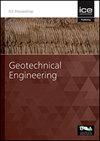压实对铁矿尾矿小应变剪切模量的影响
IF 2
4区 工程技术
Q3 ENGINEERING, GEOLOGICAL
Proceedings of the Institution of Civil Engineers-Geotechnical Engineering
Pub Date : 2022-01-17
DOI:10.1680/jgeen.21.00036
引用次数: 1
摘要
了解铁矿尾矿的岩土力学特性是目前矿业面临的最大挑战之一。这些尾矿的脆性特性使小应变刚度的重要性上升到岩土工程的前沿。然而,对铁矿尾矿特性的认识和信息仍然缺乏。本文介绍了尾矿材料小应变刚度试验程序的结果和分析。这些材料是在铁矿处理过程中产生的。本德尔单元用于测量剪切波速,并评估由各向同性固结试验产生的不同有效应力水平下的动态剪切模量。采用3种不同类型的铁矿尾矿:(1)浮选尾矿,(2)泥尾矿,(3)不同粒度分布的混配尾矿。在不同密度(松散和致密条件)下制备重建试样,以评估初始密度对剪切模量的影响(压实百分比)。将实验室结果与其他土壤类型的经验相关性进行了比较。然而,这些方程对于含有大量细粒(泥)的尾矿材料是无效的。讨论了这些方程的优点和局限性,并提出了一个新的包含压实度的经验方程。本文章由计算机程序翻译,如有差异,请以英文原文为准。
Influence of compaction on small-strain shear modulus of iron ore tailings
Understanding the geotechnical properties of iron ore tailings is one of the biggest challenges that the mining industry currently faces. The brittle behaviour of these tailings has brought the importance of small strain stiffness to the geotechnical forefront. However, lack of knowledge and information about the behaviour of iron ore tailings still exists. This paper presents the results and analysis of a laboratory program that aimed to assess the small strain stiffness of tailings materials. These materials were produced during the iron ore treatment process. Bender elements were used to measure shear wave velocities and evaluate dynamic shear moduli at different effective stress levels resulting from isotropic consolidation tests. Three types of iron ore tailings were used: (1) flotation, (2) slimes, and (3) blended with different grain-size distributions. Reconstituted specimens were prepared at different densities (loose and dense conditions) to assess initial density effects (percent compaction) upon the shear modulus. The laboratory results were compared with empirical correlations with other soil types. Nevertheless, these equations were ineffective in representing tailings materials that contain large amounts of fines (slimes). The advantages and limitations of these equations are discussed, and a new empirical equation that includes the degree of compaction is suggested.
求助全文
通过发布文献求助,成功后即可免费获取论文全文。
去求助
来源期刊
CiteScore
4.40
自引率
4.50%
发文量
68
审稿时长
3 months
期刊介绍:
Geotechnical Engineering provides a forum for the publication of high quality, topical and relevant technical papers covering all aspects of geotechnical research, design, construction and performance. The journal aims to be of interest to those civil, structural or geotechnical engineering practitioners wishing to develop a greater understanding of the influence of geotechnics on the built environment.

 求助内容:
求助内容: 应助结果提醒方式:
应助结果提醒方式:


